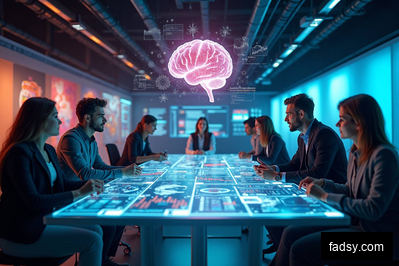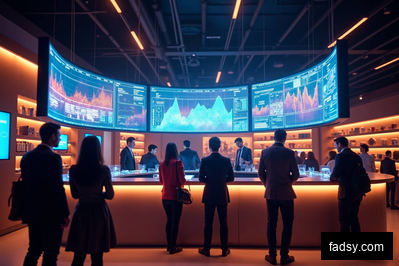Introduction
In the rapidly evolving landscape of business and technology, the ability to accurately predict and capitalize on emerging trends is invaluable. This necessitates a harmonious blend of human insight and artificial intelligence (AI). While AI can process and analyze data at an unprecedented scale and speed, human insight adds context, intuition, and ethical considerations into the mix. The synergy of these elements enhances trend analysis, making it more accurate, comprehensive, and actionable. This blog post delves into the interplay between human expertise and AI in trend analysis, exploring the benefits, challenges, and practical applications of their integration.
As we delve deeper into the realm of Introduction, it becomes evident that setting the right tone and context can significantly impact the reader's engagement. A compelling introduction not only provides a glimpse into the main topic but also sets the stage for what lies ahead. For instance, by incorporating intriguing anecdotes or thought-provoking questions, the introductory section can pique the reader's curiosity and encourage them to explore further.
The Power of Combining Human Insight with AI in Trend Analysis
Human insight and AI each bring unique strengths to trend analysis. AI algorithms excel at sifting through vast amounts of data, identifying patterns and correlations that might elude human analysts. On the other hand, human experts can interpret these patterns within the broader context of social, economic, and cultural factors. This combination allows for a more nuanced understanding of trends.
For example, AI might identify a surge in online discussions about sustainable living. However, it's the human analyst who can understand the implications of this trend for consumer behavior, regulatory changes, and market opportunities. Companies like IBM and Google have leveraged this synergy in their market research, using AI to gather data and human teams to interpret it, leading to successful product launches and marketing strategies.
When human insight and AI collaborate in trend analysis, the result is a dynamic synergy that leverages the best of both worlds. Human analysts can provide context, intuition, and real-world experience that AI algorithms may lack. Pairing this with AI's ability to process vast amounts of data at lightning speed creates a powerful combination that enhances trend prediction accuracy and strategic decision-making.
Challenges in Integrating Human Insight and AI
Despite the clear benefits, merging human insight with AI in trend analysis is not without its challenges. One major hurdle is ensuring that the AI algorithms are transparent and interpretable by humans. Without this, it's difficult for human analysts to trust and effectively use the AI's findings. Additionally, there's the risk of AI amplifying human biases if not carefully managed. For instance, if an AI system is trained on historical data that contains biases, it may perpetuate or even exacerbate these biases in its trend predictions.
Companies like Microsoft and Amazon have faced these challenges head-on by investing in explainable AI research and implementing rigorous bias checks in their AI systems. This ensures that their AI-enhanced trend analysis is both understandable and equitable.
One key challenge in combining human insight with AI lies in the interpretation of nuanced data. While AI excels in processing vast amounts of information, discerning context, emotions, and non-verbal cues remains a human forte. This becomes evident in sentiment analysis where AI may misinterpret sarcasm or cultural nuances, underscoring the need for human oversight in refining AI algorithms.
Practical Applications of Human-AI Collaboration in Trend Analysis
The practical applications of combining human insight with AI in trend analysis are vast and varied. In the retail sector, this synergy is used to forecast fashion trends, enabling companies like Zara and H&M to quickly adapt their product lines to meet emerging consumer demands. In finance, firms use AI to identify market trends and human analysts to contextualize these findings, resulting in more informed investment decisions. Similarly, in healthcare, AI can spot patterns in disease outbreaks, with human experts then evaluating these insights to formulate public health strategies.
A notable example is Netflix's use of AI to analyze viewing patterns and human creative teams to interpret these data points. This has allowed Netflix to successfully predict and create content that resonates with its viewers, contributing to its position as a leader in the streaming industry.
One key application of human-AI collaboration in trend analysis lies in the realm of financial forecasting. By leveraging AI's data processing capabilities and human expertise in interpreting market nuances, organizations can gain a competitive edge in predicting market trends with higher accuracy. Additionally, in the field of healthcare, combining AI's analytical power with human clinical insights enables more precise identification of medical trends and potential outbreaks, leading to proactive interventions and improved patient care.
Best Practices for Bridging the Gap Between Human Insight and AI
To effectively bridge the gap between human insight and AI in trend analysis, several best practices should be followed. Firstly, fostering a culture of collaboration between data scientists and domain experts is crucial. This encourages the sharing of insights and enhances the overall analysis. Secondly, investing in training for both AI practitioners and non-technical staff ensures that everyone can effectively interpret AI findings and contribute their insights.
Moreover, implementing transparent and interpretable AI systems is essential. This makes it easier for human analysts to understand how the AI arrived at its conclusions, fostering trust and enabling more effective collaboration. Lastly, regular monitoring and updating of AI systems are necessary to ensure they remain unbiased and accurate over time.
A case in point is the collaboration between Toyota and IBM on a project to predict vehicle malfunctions. By combining IBM’s AI tools with Toyota’s automotive expertise, they were able to not only identify potential issues more rapidly but also understand the root causes, leading to quicker, more effective solutions.
In addition to collaborative data interpretation, another crucial best practice for bridging human insight and AI is continuous feedback loops. By establishing feedback mechanisms, such as regular performance evaluations and user input channels, organizations can refine AI algorithms based on real-world insights. This iterative process ensures that AI systems evolve in alignment with human expertise, enhancing the accuracy and relevance of trend analysis.
Conclusion
The integration of human insight and AI in trend analysis represents a formidable tool in the arsenal of businesses aiming to stay ahead of the curve. This synergy allows for the leveraging of AI's computational power and human experts' contextual understanding, leading to more accurate, nuanced, and actionable insights. However, realizing this potential requires overcoming challenges such as ensuring AI transparency and managing biases.
By embracing best practices such as fostering collaboration between AI and domain experts, investing in transparent AI technologies, and continuous learning, organizations can harness the full power of human-AI collaboration in trend analysis. As this field continues to evolve, those who can effectively bridge the gap between human insight and AI will find themselves at a competitive advantage, capable of identifying and capitalizing on trends with unprecedented speed and accuracy.
In conclusion, the symbiotic relationship between human intuition and AI technology continues to revolutionize trend analysis across industries. By harnessing the power of AI algorithms and human expertise, organizations can unlock invaluable insights that drive strategic decision-making. For instance, in the retail sector, this collaboration has enabled brands to predict consumer behaviors with unprecedented accuracy, leading to tailored marketing campaigns and enhanced customer experiences.









